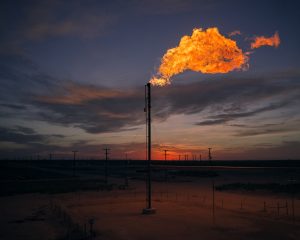 This piece originally appeared in the Houston Chronicle
This piece originally appeared in the Houston Chronicle
The Texas Railroad Commission has a unique chance to save the state’s oil and gas industry from one of its own worst habits — setting fire to over 100 billion cubic feet of natural gas each year, transforming a valuable asset into waste and pollution with zero benefit to anyone. Now, as commissioners eye production cuts in response to collapsing oil prices, they also have an opportunity to stem the profligate practice known as flaring.
The measure under consideration is called proration. Last used in the 1970s, it allows the commission to set a monthly production ceiling equal to market demand, with shares allocated among the state’s producers based on a variety of factors. Often described as a way to raise prices by limiting supply, authority for proration actually comes from the commission’s statutory obligation to prevent the waste of natural resources and protect property rights.
Flaring, of course, is the very definition of waste. Since 2013, operators in Texas have burned off roughly a trillion cubic feet of natural gas — enough to meet the yearly needs of every Texas home three times over. In 2019, Permian operators alone flared almost 300 billion cubic feet of gas, sending over a million dollars a day up in smoke.
Royalty and mineral owners — including 600,000 individual Texas households — often lose out to excess flaring. That’s because most of the state’s oil and gas producers lease their mineral rights, and many of these owners don’t get paid for gas that’s flared before it gets to market.
Flaring waste is a problem that predates the immediate economic crisis, and it will continue to dog the industry in the eventual recovery unless something is done. The issue has been especially acute in the Permian Basin, where production has exploded in recent years. And it’s a concern that the commission, industry and the public have all agreed must be addressed.
It’s time for the Texas Railroad Commission to curb flaring to prevent waste, protect property rights Share on XThat’s why some stakeholders including EDF support the idea of using flaring levels as one of the metrics for allocating production under any proration plan.
For example, the Texas Land and Minerals Owners Association, whose members together hold over 3.5 million of acres of oil and gas properties filed comments urging the commission to take flaring into account “and avoid results that give flaring wells an unfair benefit.”
University Lands, which manages oil and gas leases on 2.1 million acres in West Texas to fund higher education, likewise called on commissioners to use their proration authority to address Permian flaring, saying that it “could help in reducing oil supply, reducing the waste of natural gas and demonstrating to an observing public the industry’s commitment to continued environmental stewardship.”
The environmental benefits of doing what University Lands, TLMA, EDF and others suggest are enormous. Flaring emits a hit parade of toxic air pollutants including soot, benzene and formaldehyde, along with nitrogen oxides and volatile organic compounds. Flaring is also the largest source of carbon dioxide emissions in the oil patch and a significant contributor to the region’s growing methane problem.
The issue is such a blight on the industry’s reputation that even companies opposed to proration at a recent hearing still want the commission to do something about flaring.
Using a flaring metric in any proration process would create added incentive for producers to operate more efficiently and with less pollution and provide fair reward to those that already do. Conversely, proration without a flaring metric provides absolutely no guarantee that flaring will fall simply because production does.
Proration offers an ideal moment for the Railroad Commission to act on behalf of all Texans, now and for years to come, whether they live in the oil patch or not. Missing the opportunity would mean more waste, less money and needless harm to our health.









